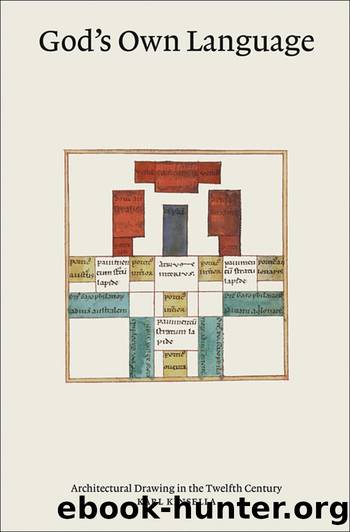God's Own Language: Architectural Drawing in the Twelfth Century by Karl Kinsella

Author:Karl Kinsella [Kinsella, Karl]
Language: eng
Format: epub
Tags: Architectural History; Medieval; Manuscripts; Architectural Drawing; Twelfth Century; Geometry; History of Science and Technology; France; Scotland; Theology
Publisher: MIT Press
Published: 2023-05-19T00:00:00+00:00
Fig. 5.2 Geometrical diagram showing the slope of the mountain. Oxford, Bodleian Library, MS Bodl. 494, f. 154v.
The drawingâs purpose is to demonstrate the relationship between the plans and the three-dimensional structure that the prophet saw and walked on. The bottom line (the adjacent side) is that which runs from A to F, and the opposite side is the vertical line containing the segments EâK. If we follow Richardâs suggestion that each segment corresponds to twenty cubits, then the distance from A to Eâwhere the adjacent and opposite sides meetâis eighty cubits. According to Richard, this adjacent line is the planum dimension, the two-dimensional length that assumes the gatehouse was located on a flat surface. In a right-angled triangle such as this, Richard proves that the hypotenuse is 100 cubits because it is the same length as the bottom line that runs from A to F. The hypotenuse represents the superficies measurement, the one that incorporates the slope of the mountain into its calculations. Knowing what each side of the triangle represents, we can then translate from one type of measurement to another. If we were to look at the diagram from above, as if floating above the triangle and looking down, we would see something like Richardâs plans. From that perspective, the planum measurement, which represents the entire width of the gatehouse, would be eighty cubits; that is, the line running from A to E. It is only when we shift perspective to how the diagram is actually presented, as if viewed from the side, that we can see the eighty cubits is an illusion resulting from the orthographic perspective of the plans, and that the same length covered by the hypotenuse is in fact 100 cubits. This geometric diagram is more like the elevations than the plans because it incorporates the three dimensions and makes the slope of the mountain and its influences on the gatehouseâs overall width plain to see.
Download
This site does not store any files on its server. We only index and link to content provided by other sites. Please contact the content providers to delete copyright contents if any and email us, we'll remove relevant links or contents immediately.
Kathy Andrews Collection by Kathy Andrews(11737)
The remains of the day by Kazuo Ishiguro(8830)
Paper Towns by Green John(5092)
Spare by Prince Harry The Duke of Sussex(5078)
Industrial Automation from Scratch: A hands-on guide to using sensors, actuators, PLCs, HMIs, and SCADA to automate industrial processes by Olushola Akande(4999)
The Body: A Guide for Occupants by Bill Bryson(4978)
Machine Learning at Scale with H2O by Gregory Keys | David Whiting(4199)
Be in a Treehouse by Pete Nelson(3955)
Never by Ken Follett(3800)
Harry Potter and the Goblet Of Fire by J.K. Rowling(3776)
Goodbye Paradise(3729)
Into Thin Air by Jon Krakauer(3314)
The Remains of the Day by Kazuo Ishiguro(3296)
The Cellar by Natasha Preston(3264)
The Genius of Japanese Carpentry by Azby Brown(3228)
Fairy Tale by Stephen King(3226)
120 Days of Sodom by Marquis de Sade(3185)
Drawing Shortcuts: Developing Quick Drawing Skills Using Today's Technology by Leggitt Jim(3001)
The Man Who Died Twice by Richard Osman(2998)
